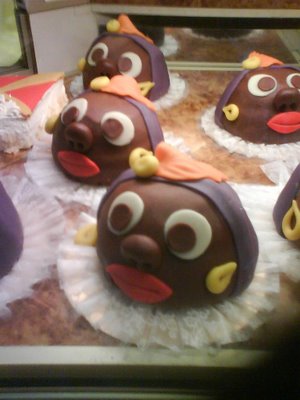Reader Jennifer E.B. alerted us to the Dutch tradition of Zwarte Piet, “Black Pete.” Jennifer writes:
I grew up in a town that was overwhelmingly Dutch. Most people in town had Dutch anscestry (though not my family), there was a Dutch festival each spring, and before Christmas there was a Sinterklaas parade (Dutch Santa Claus). When we were there for Christmas this year both of my daughters received a chocolate in the shape of their initial in their stockings from my sister. I had let them have some of the chocolate several times before the background picture on the box caught my eye.
What Jennifer saw was what looked like a character in blackface (product found here):

Jennifer did some digging and she discovered that Zwarte Piet is a traditional Christmas Sinterklaas character in the Netherlands.
Lulu Helder at the Museum of Racist Memorobilia explains:
The role is usually played by a white woman or man who wears black or brown grease paint on their faces (Saint Nicholas is always performed by a man). He or she wears large golden earrings, a curly wig and red lipstick. Right now they wear brown grease paint more often because “the blackness frightens children”.
Once the transformation is completed, a change in voice and behaviour usually follow. He or she will speak improper Dutch with a low voice and a Surinamese accent.
Below the jump are some pictures (not safe for work):
People dressed up as Sinterklaas and Zwarte Piet (from here, here, and here):



Here is a website where you can purchase Sinterklaas and Zwarte Piet costumes.
Some pictures of figurines and a book from Dutch Village:



Jennifer even found some examples of representations of Black Pete on Cake Wrecks:



Helder offers this history of Zwarte Piet:
[Beginning in the 12th century] black slave-characters that accompanied Saint Nicholas originally symbolised the devil, a ‘joker’ who was submissive, frightening and disobedient at once. At this point there were no ‘racial’ references to people of African descent. Although the Mores were also associated with the devil, the blackness of the children did not refer to them but to the devil-figure. In other words; this color bias preceded the racial-bias. When Saint Nicholas re-appeared at the end of the 18th century after being banned, he returned alone, without Black Peter.
In the 19th century the black devil returns, this time re-invented as a servant of Moorish descent. He wears the costume of the child-slaves that work in Europe at that time, the pages. Carrying a large bag and his rod he threatens to take children that behaved bad. In an era of slavery and colonialism the racial ideas of that time were translated onto this figure.
Helder reports that the Zwarte Piet character is controversial in the Netherlands, but that the opposition is not strong enough to have made much of a dent in the representation.
UPDATE: Comments on this post are now closed.
Lisa Wade, PhD is an Associate Professor at Tulane University. She is the author of American Hookup, a book about college sexual culture; a textbook about gender; and a forthcoming introductory text: Terrible Magnificent Sociology. You can follow her on Twitter and Instagram.






















